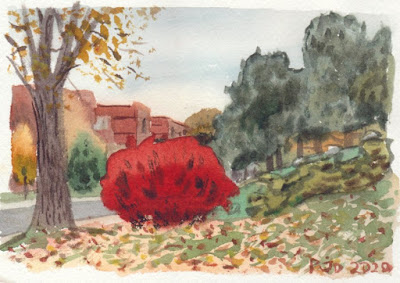Throughout the late 90's I was traveling and painting a lot, for example
around Caledon, and a
trip to California. When I graduated with my Bachelor's of Science degree, I had a summer off before I would start graduate school in the fall, and with some savings, and help from Mom and Dad, I was able to spend two months in France and Spain. The painting shown here is the first one I did on the trip- a youth hostel in Paris called Three Ducks which had a courtyard with a view of a nearby spire.
France, Paris 1 Three Ducks Tower, 5 x 7" cold press, watercolour, 1998 (No. 0830)
The last painting I did on this trip is, ironically, the first painting that I blogged about on this site, a scene of Notre Dame Cathedral. There are other paintings from France, you can see them using the 'France' label visible in the web version of the site.
After spending time in Paris it occurred to me that I couldn't afford to stay there the whole time, and that I was getting sick of baguette, cheese and cheap table wine. So I made my way down to Spain, inspired by Hemingway perhaps. This scene is the mountain that holds the Sacred Heart Monument, it is actually a small peninsula that can be reached by foot. I made other paintings from
the beach. There are many more, I will work on making a page for them.
Spain 14 San Sebastian, Sacred Heart Monument, 5.5 x 9, cold press, 300lbs, 1998 (No. 0843)
The stop was Madrid, located roughly in the center of the country. It was a big bustling city and I would only spend a few days there. Some of the best views were from the university. I used artistic license to move this building into the scene, it was actually far off to the right. It was a lonely hilltop for sure.
Spain 30 Madrid, Ciudad Universiterio Vista, 5 x 7" cold press, watercolour, 1998 (No. 0860)
While in Madrid, I did a day trip to Segovia, a small town famous for its Roman aqueducts, and throngs of tourists! It was hard finding a spot to sit. The sheer size of the aqueducts and their quality was impressive, for scale I included a small landscape at the bottom framed by the stone arches.
Spain 37 Segovia, Aqueduct, 5 x 8" cold press, watercolour, 1998 (No. 0867)
After Madrid, I visited Toledo Spain for a few days painting the Toledo Cathedral, then I turned east to Barcelona painting the impressive art museum. I followed the coast painting Valencia boats on the beach, followed by Alicante where I did a neat beach view from the castle. Continuing south I visited the Alhambra in Granada, and painted the sunset in Ronda.
Ronda was my favorite place to paint in Spain, other than San Sebastian perhaps. You can search my blog for others from Ronda. Here is one I didn't post yet, it shows a house with the greatest view in town! It was an ambitious scene, but after doing the Toledo Cathedral I was confident the rest of the trip. Somebody filmed me as I painted this with a cam quarter (with my permission) this was a time before smart phones remember.
Spain 88 Ronda, vista through three windows, 5 x 7" hot press, watercolour, 1998 (No. 0918)
In the south of Spain I stayed in what was a British colony of sorts called Gibraltar painting the ships passing by and other scenes. Here is a scene I painted of the rock of Gibraltar. If I could fit a whole cathedral on a small piece of paper, why not a small mountain? Later I would walk up the mountain and do a painting from the top. But what I remember most from this moment 22 years ago is what I ate- from my backpack I assembled a huge ham sandwich with cheese, tomato and lettuce, along with a large piece of chocolate to finish off.
Spain 102 Gibraltar, Rock of Gibraltar, 5 x 8" cold press, watercolour, 1998 (No. 932)
I could keep going telling stories in this blog but I will try to wrap it up shortly. After Gibraltar, which was not a very pleasant place to visit, I headed north through Seville, Cordoba, Salamanca, Zamora, and back to Paris via Irun.
I will leave you with one last painting, it is a close-up of a famous decoration on the outside of the University building. The facade is very ornate with hundreds of carvings, and in among the myriad of shapes is a hidden frog. Finding the frog is like a tourist magnet, the tour guides bring great throngs of visitors by to search for the darn amphibian. When I went, there was a smart ass local fellow who would jump in and point at it, ruining the fun. Well it was fun for him which was fair enough he lived there. So I came back one day when there weren't so many tourists and made this painting. Spoiler alert, if you are planning to go to Spain some day look away!
It is that disappointing little blob on top of the skull by the way.
Spain 145 Salamanca, Hidden Frog, 5 x 8" cold press, watercolour, 1998 (No. 0977b)






















































